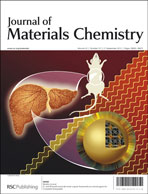Via density functional theory computation and experimental validation, we have compared the catalytic activities of different facets within Bi2S3, as counter-electrode (CE) materials for dye-sensitized solar cells (DSSCs). The (130) facet has the largest surface energy, the best electronic conductivity, and the highest position of conduction band minima, indicating the most effective electron transfer from CEs to I−3 and the highest catalytic activities of Bi2S3 with (130) facets. To testify the computations, we also synthesized flower-like Bi2S3 nanostructures with dominantly exposed (130) and (211) facets, respectively, and investigated their catalytic activities through impedance spectra, I–V curves and conversion efficiency tests. DSSCs with (130) and (211) faceted Bi2S3 CEs exhibited conversion efficiencies of 3.5% and 1.9%, respectively, which further confirmed the superiority of (130) facets within Bi2S3. The findings provide some clues for designing and applying low-cost Pt-free DSSC CE materials from inorganic nanostructures.

You have access to this article
 Please wait while we load your content...
Something went wrong. Try again?
Please wait while we load your content...
Something went wrong. Try again?


 Please wait while we load your content...
Please wait while we load your content...